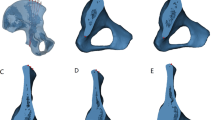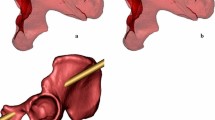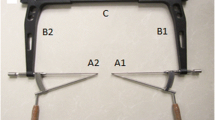Abstract
Purpose
To test whether a novel guide template we designed can facilitate accurate insertion of antegrade lag screws in the fixation of acetabular posterior column fractures.
Methods
We created virtual three-dimensional reconstruction models of the pelvis from CT scan data obtained from 96 adult patients without any bony problems. A virtual cylindrical implant was placed along the longitudinal axis of the acetabular posterior column passing through the ischial tuberosity. The diameter of cylindrical implant was augmented to 6.5 mm, and the direction was adjusted until the optimal screw path was found using the reverse engineering technique. The orifice of this cylinder from the iliac fossa was determined as the entry point for the antegrade lag screw. The anatomical parameters of the screw entry path were measured and saved in .stl format. The guide template was designed according to the acetabular morphology and the measured anatomical parameters before it was put into manufacture of a solid template with the rapid prototyping technique. The feasibility and accuracy of the guide template were tested in cadaveric pelvises. Finally, the guide template was used in real surgery for five patients. Furthermore, the time required for surgery was recorded.
Results
Under the guide of this navigation template, antegrade lag screws were successfully placed in the posterior column of the acetabulum in the cadaveric test. And five lag screws were successfully placed in five patients. The mean time of antegrade lag screw insertion required 5.8 (3–10) min.
Conclusions
Antegrade lag screws can be more accurately put into the posterior column of the acetabulum with the help of this navigation template.




Similar content being viewed by others
References
Gansslen A, Oestern HJ (2001) Acetabular fractures. Chirurg 82:1133–1148, quiz 49-50
Schmidt-Rohlfing B, Reilmann H, Pape HC (2010) Fractures of the acetabulum. Diagnostic and therapeutic strategies. Unfallchirurg 113(3):217–229
Matta JM, Anderson LM, Epstein HC, Hendricks P (1986) Fractures of the acetabulum. A retrospective analysis. Clin Orthop Relat Res 205:230–240
Milenkovic S, Saveski J, Radenkovic M, Vidic G, Trajkovska N (2011) Surgical treatment of displaced acetabular fractures. Srp Arh Celok Lek 139(7-8):496–500
Briffa N, Pearce R, Hill AM, Bircher M (2011) Outcomes of acetabular fracture fixation with ten years’ follow-up. J Bone Joint Surg (Br) 93(2):229–236
Giannoudis PV, Grotz MR, Papakostidis C, Dinopoulos H (2005) Operative treatment of displaced fractures of the acetabulum. A meta-analysis. J Bone Joint Surg (Br) 87(1):2–9
Harris AM, Althausen P, Kellam JF, Bosse MJ (2008) Simultaneous anterior and posterior approaches for complex acetabular fractures. J Orthop Trauma 22(7):494–497
Wang G, Pei G, Gu L, Zhu L, Guo G, Xia T (2002) Operative treatment of acetebular fractures. Zhonghua Wai Ke Za Zhi 40:657–661
Kaempffe FA, Bone LB, Border JR (1991) Open reduction and internal fixation of acetabular fractures: heterotopic ossification and other complications of treatment. J Orthop Trauma 5(4):439–445
Chang JK, Gill SS, Zura RD, Krause WR, Wang GJ (2001) Comparative strength of three methods of fixation of transverse acetabular fractures. Clin Orthop Relat Res 392:433–441
Shazar N, Brumback RJ, Novak VP, Belkoff SM (1998) Biomechanical evaluation of transverse acetabular fracture fixation. Clin Orthop Relat Res 352:215–222
Mouhsine E, Garofalo R, Borens O, Wettstein M, Blanc CH, Fischer JF, Moretti B, Leyvraz PF (2005) Percutaneous retrograde screwing for stabilisation of acetabular fractures. Injury 36(11):1330–1336
Starr AJ, Reinert CM, Jones AL (1998) Percutaneous fixation of the columns of the acetabulum: a new technique. J Orthop Trauma 12(1):51–58
Hong G, Cong-Feng L, Cheng-Fang H, Chang-Qing Z, Bing-Fang Z (2010) Percutaneous screw fixation of acetabular fractures with 2D fluoroscopy-based computerized guide. Arch Orthop Trauma Surg 130(9):1177–1183
Gansslen A, Krettek C (2009) Internal fixation of acetabular both-column fractures via the ilioinguinal approach. Oper Orthop Traumatol 21(3):270–282
Connelly CL, Archdeacon MT (2012) Transgluteal posterior column screw stabilization for fractures of the acetabulum: a technical trick. J Orthop Trauma 26(10):e193–e197
Yu YH, Tseng IC, Su CY, Huang JW, Wu CC (2011) Modified technique of percutaneous posterior columnar screw insertion and neutralization plate for complex acetabular fractures. J Trauma 71(1):198–203
Rommens PM (2007) Is there a role for percutaneous pelvic and acetabular reconstruction? Injury 38(4):463–477
Ochs BG, Gonser C, Shiozawa T, Badke A, Weise K, Rolauffs B, Stuby FM (2010) Computer-assisted periacetabular screw placement: comparison of different fluoroscopy-based guide procedures with conventional technique. Injury 41(12):1297–1305
Oberst M, Hauschild O, Konstantinidis L, Suedkamp NP (2012) Effects of three-dimensional guide on intraoperative management and early postoperative outcome after open reduction and internal fixation of displaced acetabular fractures. J Trauma Acute Care Surg 73(4):950–956
Mu WD, Wang XQ, Jia TH, Zhou DS, Cheng AX (2009) Quantitative anatomic basis of antegrade lag screw placement in posterior column of acetabulum. Arch Orthop Trauma Surg 129(11):1531–1537
D’Aubigne RM, Postel M (1984) Functional results of hip arthroplasty with acrylic prosthesis. J Bone Joint Surg 36A:451–475
Prasartritha T, Chaivanichsiri P (2013) The study of broken quadrilateral surface in fractures of the acetabulum. Int Orthop 37(6):1127–1134
Abo-Elsoud M, Radwan YA, Gobba M, Sadek F (2014) Short-segment fixation through a limited ilioinguinal approach for treating anterior acetabular fractures: a historical-control study. Int Orthop 38(7):1469–1475
Bronsema E, te Stroet MA, Zengerink M, van Kampen A, Schreurs BW (2014) Impaction bone grafting and a cemented cup after acetabular fracture. Int Orthop 38(12):2441–2446
Shahulhameed A, Roberts CS, Pomeroy CL, Acland RD, Giannoudis PV (2010) Mapping the columns of the acetabulum—implications for percutaneous fixation. Injury 41(4):339–342
Dienstknecht T, Muller M, Sellei R, Nerlich M, Muller FJ, Fuechtmeier B et al (2012) Screw placement in percutaneous acetabular surgery: gender differences of anatomical landmarks in a cadaveric study. Int Orthop 37(4):673–679
Zhang YZ, Lu S, Xu YQ, Shi JH, Li YB, Feng ZL (2009) Application of guide template to fixation of sacral fracture using three-dimensional reconstruction and reverse engineering technique. Chin J Traumatol 12(4):214–217
Hernigou P, Ratte L, Roubineau F, Pariat J, Mirouse G, Guissou I, Allain J, Lachaniette CH (2013) The risk of dislocation after total hip arthroplasty for fractures is decreased with retentive cups. Int Orthop 37(7):1219–1223
Bagaria V, Deshpande S, Rasalkar DD, Kuthe A, Paunipagar BK (2011) Use of rapid prototyping and three-dimensional reconstruction modeling in the management of complex fractures. Eur J Radiol 80:814–820
Fu M, Lin L, Kong X, Zhao W, Tang L, Li J, Ouyang J (2013) Construction and accuracy assessment of patient-specific biocompatible drill template for cervical anterior transpedicular screw. PLoS One 8(1), e53580
Jin D, Wang D, Zhang YZ, Xiang DY, Qin Y, Pei GX (2009) Design and preliminary clinical application of a new digitalized guide template for fixation of the inferior tibiofibular joint. Nan Fang Yi Ke Da Xue Xue Bao 29(7):1364–1366
Author information
Authors and Affiliations
Corresponding author
Rights and permissions
About this article
Cite this article
Chen, H., Wang, G., Li, R. et al. A novel navigation template for fixation of acetabular posterior column fractures with antegrade lag screws: design and application. International Orthopaedics (SICOT) 40, 827–834 (2016). https://doi.org/10.1007/s00264-015-2813-8
Received:
Accepted:
Published:
Issue Date:
DOI: https://doi.org/10.1007/s00264-015-2813-8




